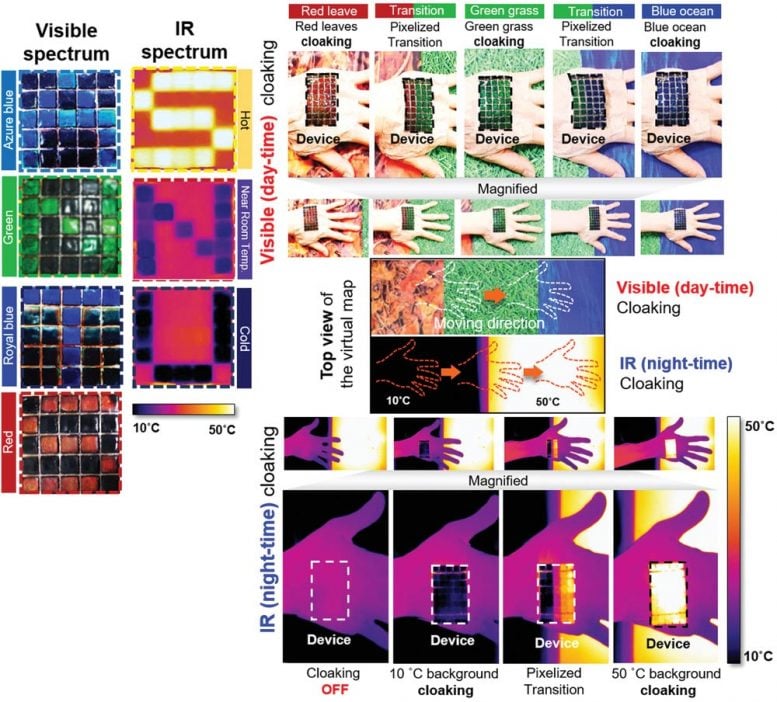
Cephalopods’ exceptional ability to hide into any background has inspired researchers to replicate their fascinating ability to camouflage in the infrared (IR) and visible spectrum. Recent advances offered a number of physical mechanisms to reproduce the cloaking functionalities of cephalopods. However, most of works focused on either camouflaging in the visible or IR camouflage range only: not dual modes in a single device structure that can readily switch between the visible and IR mode according to a suitable situation. Credit: Seoul National University
Thermally controlled, active imperceptible artificial skin in visible-to-infrared range.
Cephalopods’ exceptional ability to hide into any background has inspired researchers to replicate their fascinating ability to camouflage in the infrared (IR) and visible spectrum. Recent advances offered a number of physical mechanisms to reproduce the cloaking functionalities of cephalopods. However, most of works focused on either camouflaging in the visible or IR camouflage range only: not dual modes in a single device structure that can readily switch between the visible and IR mode according to a suitable situation.
Recently, Prof. Seung hwan Ko’s group in Seoul National University in Republic of Korea demonstrated the visible-to-IR active ands camouflage skin that provides an on-demand cloaking platform both in daylight and at night with a single input variable: Temperature (T). The soft thermoelectric device that is capable of active cooling and heating serves as a backbone structure to fine-tune the surface of each pixel and thereby enables thermal camouflage in the IR range by matching the ambient temperature. The Ko’s group further extended the camouflage range to the IR-to-visible spectrum by incorporating thermochromic liquid crystal at the surface that changes light reflectance (R) based on the device temperature, enabling the expressing a variety of colors by controling temperature. The camouflage system as a whole encompasses the two independent spectrums into a ‘full spectrum’ with a single soft structure by controlling temperature.

Cephalopods’ exceptional ability to hide into any background has inspired researchers to replicate their fascinating ability to camouflage in the infrared (IR) and visible spectrum. Recent advances offered a number of physical mechanisms to reproduce the cloaking functionalities of cephalopods. However, most of works focused on either camouflaging in the visible or IR camouflage range only: not dual modes in a single device structure that can readily switch between the visible and IR mode according to a suitable situation. Credit: Seoul National University
In addition to the device capability to camouflage during both day and night, the device is highly ‘pixelized.’ This way, the camouflage skin can blend into the sophisticated thermal and chromic background or even camouflage when it is in the transient motion from one background to another. Finally, the group demonstrated the actual artificial camouflage skin on the human epidermis that is capable of camouflaging into 1. sophsticated background such as bush or 2. when moving from one background to another both in the IR and visible spectrum.
Reference: “Thermally Controlled, Active Imperceptible Artificial Skin in Visible-to-Infrared Range” by Jinwoo Lee, Heayoun Sul, Yeongju Jung, Hyeonseok Kim, Seonggeun Han, Joonhwa Choi, Jaeho Shin, Dongkwan Kim, Jinwook Jung, Sukjoon Hong and Seung Hwan Ko, 14 July 2020, Advanced Functional Materials.DOI: 10.1002/adfm.202003328
Participating researchers: Jinwoo Lee (Seoul National University), Heayoun Sul (Seoul National University), Yeongju Jung (Seoul National University), Hyeonseok Kim (Seoul National University), Seonggeun Han (Seoul National University), Joonhwa Choi (Seoul National University), Jaeho Shin (Seoul National University), Dongkwan Kim (Seoul National University), Jinwook Jung (Seoul National University), Sukjoon Hong (Hanyang University), and Seung Hwan Ko (Seoul National University).
This work was supported by the National Research Foundation of Korea (NRF) Grant funded through the Basic Science Research Program (2017R1A2B3005706).